
If you have a blog and you publish posts on it regularly, then you definitely want them to be read by as many people as possible.
How do you drive traffic to your blog? There are several different ways to make this happen.
#1. You can pay for it by advertising on Facebook.
#2. You can use social media like Twitter, LinkedIn, Facebook, Pinterest or Web 2.0 sites like Tumblr to promote your blog post on and try to reach as broad an audience as possible.
#3. You can share your work with your personal network.
#4. You can continue to read this article for even more ideas.
You can also rank highly in Google search results. This is what we?re going to focus on in this post.
In this piece, I will explain to you how to improve the search engine rankings for your blog posts so that you can rank on the first page of Google and receive a lot of free organic traffic.
Everyone would like to be on the first page of Google, preferably on the first spot at the top of the page. The problem is that there are only ten search results on each page of the Google search engine and only one site can be ranked first.
The competition for the first spot is always high. Even if you rank in the first position, there isn’t a traffic boost guarantee. It all depends on the headline of your article. The most captivating headline will get the highest amount of clicks, even if a page isn’t ranked #1.
There are two terms you should keep in mind: on-page SEO and off-page SEO
On-page optimization is what you do within your website to improve its position in the search rankings.
Off-page optimization is what you do outside of your site to make it rank better.
In this post, I?m going to tell you what I do and what you can do right now to begin the optimization process for your posts so that they have a better chance to appear on the first page of Google.
Keys To On-Page Optimization?
Keywords
Before starting to write a blog post, you should first find a keyword that you would like to target and create content around it. Think of this keyword as your thesis statement. You’re creating something engaging and valuable that relates to this keyword.
Value is the measurement that we must use for ranking today. In the past, stuffing tons of keywords into content worked to boost rankings. It doesn’t work today. It may work for a short period of time, but Google will always find these posts and lower their ranking.
Go to Google’s Keyword Planner or any other keyword research tool that you like (personally I use Jaaxy) and type in your desired phrase, e.g. how to make more money online.
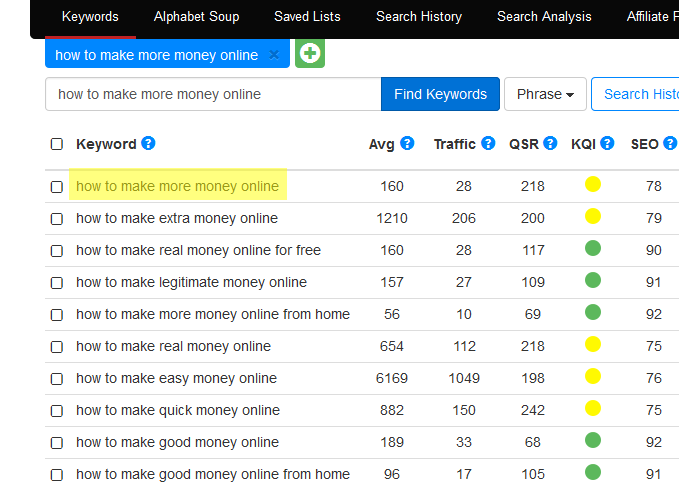
If you decide to go after this keyword, then make sure that you use it in the title of your post. The best practice here is to use your main keyword as close to the beginning of the title as possible. It is proven that it helps in ranking.
[quote]Place important keywords close to the front. The closer to the start of the title tag your keywords are, the more helpful they’ll be for ranking, and the more likely a user will be to click them in the search results.?[/quote] Source: moz.com
For example, if you write your title like this: How to Make More Money Online Using These 10 Tactics…

…instead of All You Ever Wanted to Know About How To Make More Money Online…

…the first title should rank better than the second for this given keyword.? Remember that if your title is longer than 65 characters, Google will cut it off.
Using your keyword in the title is not everything.
You should mention it within the body of your article as well, but do not overuse it.
If you use the keyword within the first 100-150 words of the article and maybe somewhere at the end of the article (last paragraph) once again ? that should be enough.
There is something more important that just repeating the same keyword twice in the article: LSI keywords.
LSI Keywords (Latent Semantic Indexing Keywords) are keywords that are closely related to the main keyword. Using both your primary keyword and LSI keywords in your content will help your post rank in Google for many different search terms at the same time.
If you?re lucky enough to rank on the first page of Google for the search term ?how to make more money online? by using LSI keywords, you can also rank for ?ways to make extra money online,? ?work from home online,? ?earn money online,? and others.
In order to find useful LSI keywords, you can use the ?searches related to …? at the bottom of the page, Google Instant Technique or such tools as Ubersuggest,?Ultimate Keyword Hunter or just your favorite keyword research tool.
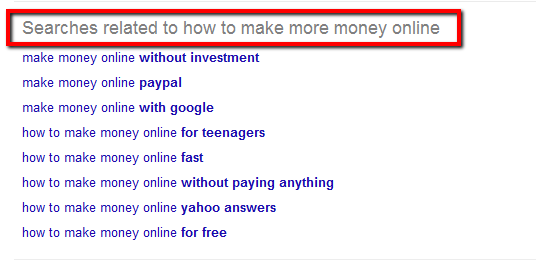
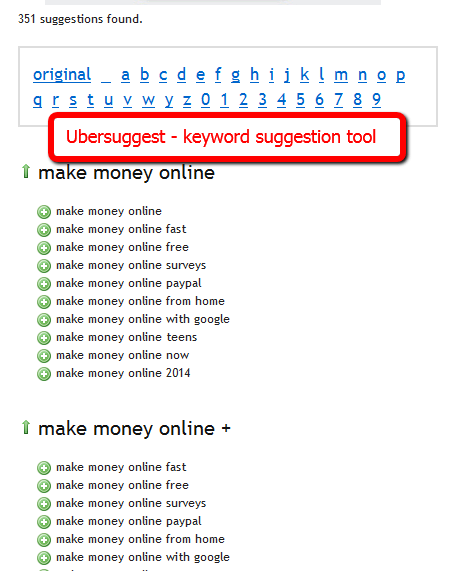
Once you?ve created a list of all the LSI keywords you would like to use in your content, I suggest to use some of them before publishing the post and then use some of them a few weeks later (3-6 weeks) after publishing the post.
Why not use all of them at once?
Because Google likes fresh and updated content. If after a few weeks you update your old post, add 500-700 or more words to it that include some of the LSI keywords, you can expect a nice boost in rankings. I’ve used this method consistently. It WORKS.
When you use LSI keywords in your posts, it?s best to use them as subheadings (H2/H3/H4 tags). If your main keyword in the title is ?how to make more money online,? then you just create subheadings with your LSI keywords:
Ways to Make Extra Money Online
Work From Home Online
Good Ideas to Make Money
Then write relevant content that relates to your primary keyword AND your selected subheading for an extra value boost.
Don?t Neglect the Meta Description?
Meta descriptions are important when it comes to CTR. It is the text which appears right below the title of your post.
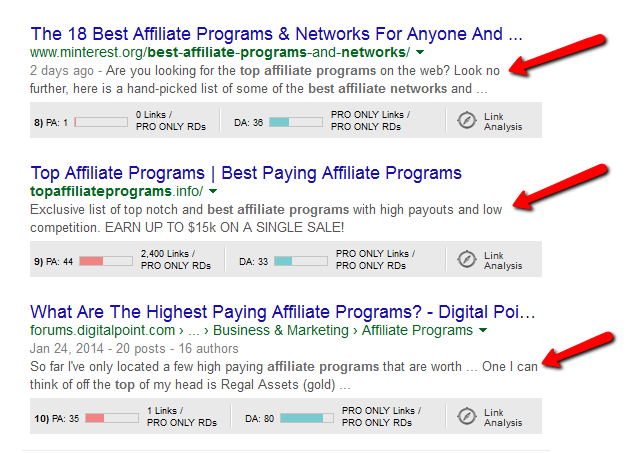
Make sure you keep it between 150-160 characters. If it?s longer, then Google will cut it off.
When writing a meta description, use your main keyword and at least 1-2 secondary keywords (LSI keywords) in a natural way.
If you use All in One SEO Pack plugin, you should find such box at the bottom of each of your blog posts.
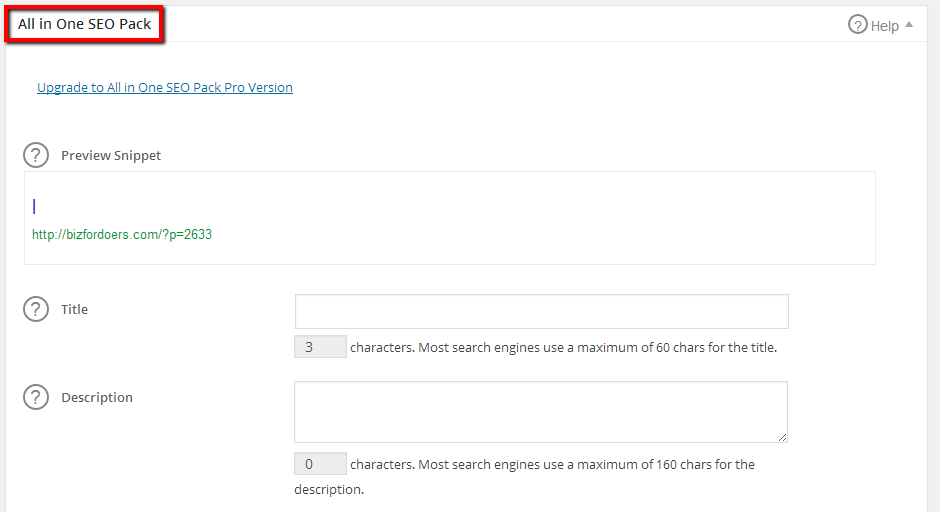
Meta descriptions are not as important as the titles of your posts, but you shouldn?t ignore them.
They can increase your click through rate and help your posts rank better in Google because people who are on the fence for a click on your link are going to read this content.
Make Content Be At Least 1500 Words in Length
Another factor which plays a vital role in the ranking of your blog posts is content length.
In the past it was said that 500-word long articles were enough to get to the first page of Google. And it was true!
Writing short articles and including a lot of spammy, low quality backlinks could help websites achieve high positions in the search engines. This is how it worked in the past.
Today the search engines are much smarter and the rules of the game have changed. It has been proven that longer articles not only rank better, but they also rank for more search terms.
This once again comes back to the value component of what is being posted.
If you?re targeting a low-to-medium competition keyword, then a 1500 word content item would be enough. If you?re trying to rank for a pretty competitive keyword, however, then you should definitely create longer articles: 2000 + words.
Longer articles let you write about something in more detail and you can use more LSI keywords in such articles.
They get shared more often and as a result get more organic backlinks, which of course helps them to gain better rankings in Google.
[quote]The average content length for a web page that ranks in the top 10 results for any keyword on Google has at least 2,000 words. The higher up you go on the search listings page, the more content each web page has.?[/quote] Source: QuickSprout
Make Your Posts Easily Sharable?
When you create a blog post, then you want it to be seen by as many people as possible. For this reason, you should make sure that your posts are easily sharable so that anyone at any time can click the given button.
The more people who see your post, then the better chances are, provided it?s a really good post, that they will also share it and that they will start linking to it.
And getting quality backlinks is a very important factor in ranking.
There are different plugins you can install to make your content easily sharable. The one I?m using is Tweet, Like, Google + and Share plugin.

This floating social bar is something I recommend you install on your blog as well. Of course you can have social buttons at the beginning and at the end of your posts, but in my opinion a floating vertical share bar is the best option.
The floating vertical option always keeps social sharing in the reader’s mindset.
They will naturally want to share the content if they found it interesting. If a reader has to scroll around to find the share links, then there’s a good chance they will just move on.
Images and Videos
If you want to rank higher in Google and make your posts look more interesting and get more social shares and backlinks, you cannot forget about using videos and images in your posts.
Most people don?t like to read blocks of text which are not separated by an image or a video. Different forms of content add variety and give readers a rest from absorbing text-based information.
By using videos and images, you can also incorporate a few more keywords in your posts.
How? If you want to embed a video from YouTube, then use the one which has a relevant keyword in the title.
For example: if your main keyword is ?how to learn to play the piano,? then look for a video with this keyword in the title.
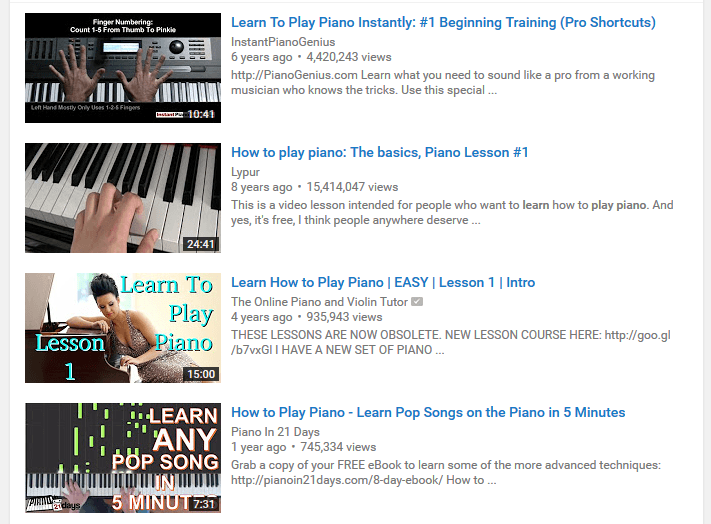
If you don?t find a video that has a keyword in the title, then just use the one that will be relevant to your post and add some extra information.
I would use one video per 1000-1200 words. So if your blog post counts 1200-1500 words ? use 1 video. If it counts 2000-2500, then use 2 videos and so on.
It?s the same rule with images.
Use relevant images to make your posts more entertaining and to use additional keywords.
Once you upload the image to your blog, then just edit it and add keywords in the right boxes.
Remember not to repeat the same keywords – use LSI keywords instead.
I would use 1 image per 300-500 words. So if your post counts 1500 words, use at least 3 images.
Linking Out to Others?
Another factor which may help you rank your posts higher is linking to outside high authority sites.
Links from popular sites are very beneficial because they let Google know that our site is trustworthy. Many bloggers, however, do not want to link to outside sources because they believe that they will lose traffic this way.
You gain traffic with outside links. Google wants to see two-way traffic on websites.
You will always gain back any traffic losses from linking outward by ranking higher in Google?s organic search results.
When search engines crawl your site and see a link going to a high authority site that is relevant to your materials, then they will often reward you for it.
Look at it this way: if you write about something and then put a link in the text that goes to a website where one can find more detailed information about the given subject, Google will see that you put in some effort to find a relevant source of information that will be helpful to your readers.
This verifies the information that you published is accurate, which means it has value. Do you think Google will then reward you or punish you for it?
[quote]External linking is good for SEO and you should do it in order to boost your rankings.[/quote] Source: moz.com
Don?t Forget About Internal Linking
[quote]Internal linking has 3 main purposes:
- Aids in website navigation
- Defines the architecture and hierarchy of a website
- Distributes page authority and ranking power throughout the site.[/quote]
? Source: kissmetrics.com
By linking internally, you?re telling Google that the given page you are linking to has importance and that Google should pay more attention to it.
[quote]?Internal links are valuable not just because they are a direct signal that your content is important, but also because those links themselves pass on their own link authority.?[/quote] Source: hubspot.com
Remember to link to pages that will let the readers understand something in more detail. If the given page doesn?t have related content that would be helpful to readers, then you shouldn?t link to it.
Good internal links add value. Poor internal links subtract value.
In a single post you should allow two links to pass within the same category and one link to pass to another category.
Page Load Speed is Important for SEO??
If you?re serious about ranking your site in Google, you cannot ignore this factor.
Site speed is important not only for SEO, but also for the user experience. Many visitors to your website will leave if the page load time is longer than 3-4 seconds.
This will affect your bounce rate, which affects your value, which therefore affects your Google ranking.
If you want to check your site speed, you can use the Pingdom Speed Test tool.
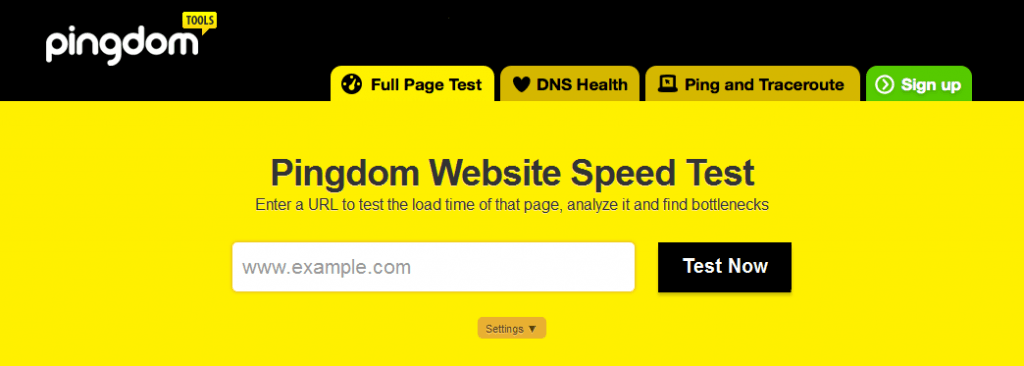
If you want to learn more about how to increase your website performance, click here.
There are a few plugins you could install to improve your site speed as well:
- W3 Total Cache
- WP Smush It
- EWWW Image Optimizer
- GZip Ninja Speed Compression is used to compress the site
Click here to see how to configure the above plugins.
Sometimes a conflict arises between the plugins and one of them needs to be deactivated to make your website work properly.
If you install the 4 plugins above and then notice that something is wrong, you will probably need to get rid of one of them via the trial and error process.
The Benefits of Off-Page Optimization
[quote]Off-Page SEO refers to all the things that you can do directly OFF your website to help you rank higher, such as social networking, article submission, forum & blog marketing, etc.[/quote] Source: onlineincometeacher.com
Off-page SEO is as important as on-page SEO. If you really want to get to the top of the first page of Google, then it cannot be neglected.
I?ll tell you about my 4 favorite off-page optimization techniques which I use to boost the rankings of my blog posts.
#1. Publish Press Releases?
[quote]?Press release distribution is an effective way to be found, increase traffic and sales while not overly spending like you would for a large-scale advertising campaign.?[/quote] Source: services.marketersmedia.com
I like publishing press releases to receive high quality backlinks from different sites.
Of course I don?t use this off-page SEO technique with every new blog post I publish. I use it mostly when the topic of the blog post is particularly important to me and I am targeting a competitive keyword in this given blog post.
Press releases are intended to inform people of something that is valuable to them. If your blog post has no value, then there’s a good chance any press release created about it will not have value either.
The benefits of a press release are clear. By publishing one, you not only receive many valuable backlinks to your article, but you also have a chance to rank highly in Google because of the extra incoming links.
This can happen within minutes. It all depends on how many sites your press release will be published on and what level of domain authority they happen to have.
Here’s an example: a press release is published by a local TV station on their website and by three national online sites that specialize in press releases.
The local TV station provides a local SEO boost for the blog post. The national online sites offer a glimpse of niche expertise, which can boost overall keyword ranking.
This is why a good press release that represents a valuable blog post will always be a win/win scenario.
Here you can learn more about how to write a press release and which distribution service to use to have your PR distributed across the internet.
There are free and paid services, but needless to say, the paid ones are much better.
Therefore if you take your online business seriously, you should consider using the paid press release distribution services to achieve the best possible results.
#2. Guest Blogging
If you want to quickly build a list of subscribers, drive more traffic to your site, or increase your site authority and position yourself as an expert, then you must take guest blogging seriously.
Although Matt Cutts from Google said that guest blogging is ?done,? what he really meant was that spammy and low quality guest blogs can get you into trouble.
If your guest posts are of a high enough quality, then you have nothing to worry about ? they still work.
Guest blogging works much better for driving traffic and building a list of subscribers when directly compared to solely using high quality backlinks.
The author of the guest post is usually allowed to put a link back to their site at the very bottom of the article, but these links are not very powerful. It?s better if you manage to put a link to your site somewhere in the body of the article.
Want to know how to find a relevant website where you will be able to publish your guest post?
Here are a few techniques that you can use. Type into the Google search bar:
?keyword? + ?guest post?
?keyword? + ?write for us?
?keyword? + ?about the author?
?keyword? + ?this post was written by?
According to Neil Patel from QuickSprout, if you don?t want to annoy Google by guest posting, you should do the following:
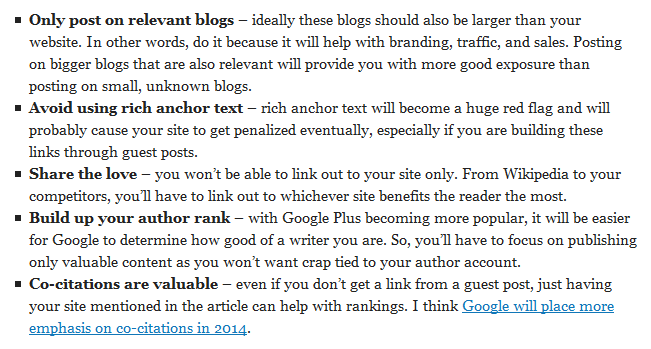
#3. YouTube Videos

Whenever I publish a new post, I like creating a YouTube video just to send a backlink to my newly published article. This is used to increase the traffic to it.
YouTube videos tend to rank very well in Google (since it is their service, after all) and it is much easier to rank your new video rather than your new post on a fresh blog.
All links coming from YouTube are no follow links, but this isn’t necessarily a bad thing. Many optimization professionals will tell you that no follow links have no value, but I would disagree.
They do have value, but they are just not passing on the link equity that the YouTube domain has developed.
[quote]Matt Cutts has stated that their engine takes “nofollow” literally and does not “follow” the link at all. Studies have revealed that Google does follow the link, but it does not index the linked-to page, unless it was in Google’s index already for other reasons.[/quote] Source: weidert.com
Google prefers balance, so you need a healthy mix of no follow and do follow links in order to make your link profile look natural.
To create YouTube videos quickly and easily, I use a program called VideoScribe.
Once your video is ready, then you just need to add a description, tags, and the right title to it. To learn more about how to rank YouTube videos, please click here.
I?ve created many YouTube videos so far and have noticed that they help me bring more visitors to my blog.
For this reason, even if YouTube vidoes wouldn?t help your post rank better in Google, it still makes sense to make them and link from them to your blog posts.
#4. Forums and Social Media
I?ve already mentioned social media above where I wrote about making your posts easily sharable.
Being active on social media really makes sense. By helping people and linking to your posts whenever it is relevant, you not only drive more traffic to your blog, but also improve your search rankings.
Whenever I publish a new post I go to Facebook, Pinterest, Twitter and Google + and put a link to my newly published blog post on each of these sites. (Don?t forget to include a link to your websites in your social profiles.)
If you have many high quality followers on your social channels, they will share, repin or retweet your posts.
Search engines pay attention to how many people interact with you. The more people see your posts the more chances you have to get backlinks.
All of these benefits are the same with forums.
When you create your forum account, you can also include a link to your site. You can include one or two in your signatures. Just don’t create an account on the given forum, leave a link and forget about it.
You must be an active forum participant in order to maximize the value your site can receive from this option.
Don’t spam the forums either by making multiple accounts or posting the same comments multiple times on different conversation chains.
You need to be active from time to time on the forums where you left your links in a conversational and beneficial way.
Otherwise it may do more harm than good.
The more active you are in any given forum, then the more potential readers will be able to see your profile, your signature, and your contributions.
In Conclusion
As you can see, you can improve the search engine rankings for your blog posts in many different ways.
I pay particular attention to specific on-page SEO options, such as the speed of my site, the length of my articles, and LSI keywords.
As for off-page SEO, I like publishing press releases, working with guest posts, and creating YouTube videos.
What other ways do you know that help improve Google rankings of your blog posts??
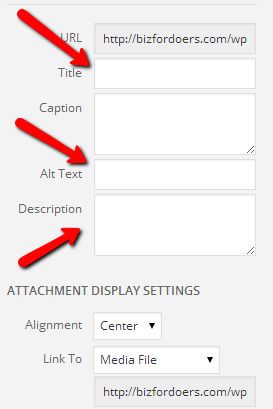
You have a pretty good write up here on how to improve Search Engine Rankings. I myself have been working to try and better my own blog and have found plenty of helpful ideas while browsing through your list. Thanks for the help I’m sure it will help me out in the long run.
Thanks. I’m happy you found some helpful ideas in it.
The article was very informative, this is the first time I ever heard of the term LSI Keywords (Latent Semantic Indexing Keywords. I was taught to make sure that the Keyword in the title is the same Keyword in the article. I enjoy the information about using video in your blog post.
Yes, LSI keywords are very important. Good luck with your online business.
This is an interesting and nicely written text, enormously lengthy, one must appreciate hard work you invested here. I did not know that one can pay for advertising on Facebook, but in fact this is logical, the owner of FB did not become rich so quickly for no reason.
You write that you update ‘old post’ after a few weeks. It is hardly an old post, isn’t it. But you say it works so it is worth trying, thank you for this.
You suggest a floating social bar (which irritates me a lot), but you yourself are not using it. You have it fixed at the sidebar, which I in fact like, perhaps it was the matter of terminology only? In any case, thank you.
Hey,
Yes, I have a social bar on the left-hand side of the page. What I meant is that it should be visibile all the time while you’re scrolling down the page.
Hey Luke. This is text-book like stuff! I have bookmarked this page, as I am sure I will be referring back to it often. Thanks for including a bunch of useful tools as well – Pingdom is awesome. Quick question; do you recommend writing an article or post in draft form, doing the LSI keyword research, editing the piece with those keywords placed as you have suggested, then publishing? Only reason I ask is, my brain likes to spit stuff out, when it does, i try to stay out of its way :). A lot of times I write content without even specific keywords in mind. probably not the best tactic, but so far its the only way I seem to accomplish anything. What’s your thoughts? Thanks again.
Michael
Hi Michael. Yes, why not. Just try to create a great piece of content without thinking about keywords. Just keep writing until you’re satisfied. I wouldn’t even stop to correct grammar or spelling mistakes (you can do it later). Then come back and edit the article adding the LSI keywords. I think it’s a good strategy. 🙂